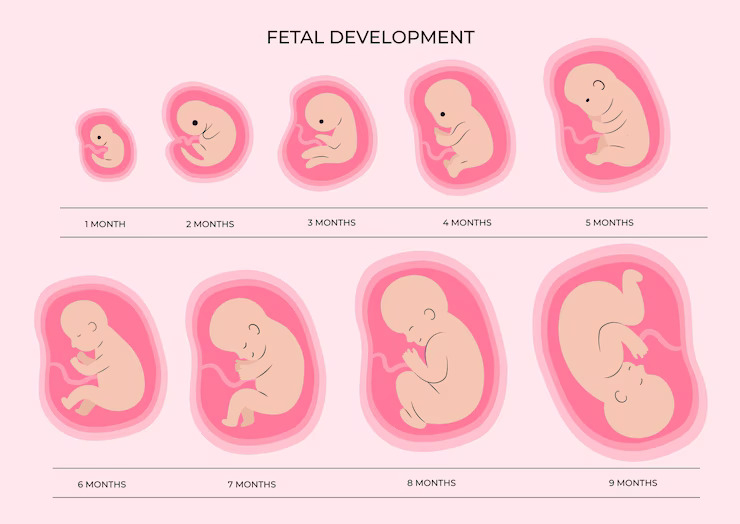During pregnancy, the mother or the whole family is very excited and invested in knowing every small detail about the developing fetus. The fetal chart is a tool that can be very helpful in estimating the weight and length of the fetus during pregnancy based on the number of weeks. This fetal chart is prepared based on data collected from several pregnancies that includes the average weight of the fetus at different gestational ages. Every expecting parent or their family wants to keep track of the baby’s development and how they are growing. There are many different scales available to measure the weekly growth of the baby; a fetal chart is one such measuring scale to measure the developing fetus in grams. In this article, we will discuss what a fetal chart is, why it is important, its significance, and how to interpret the weight and growth of the baby and its beneficiaries. This helps you have all the information you need to have satisfaction and insurance that your baby is happy and healthy.
How to read and interpret the fetal growth chart -
The fetal weight chart is a very common tool used to estimate the weight of your baby and is very easily available on the internet or in any pregnancy book. To interpret the fetal weight and growth chart all you need to know is your last menstrual period (LMP) or your current gestational age.
The fetal and growth chart is just an estimate; your baby may be larger or smaller in length than the estimated chart suggested because of various factors. You have to remember that every baby is different from the other. Many factors affect the growth of the baby. So, your baby may have a different growth rate in the first trimester resulting in a larger or smaller than the estimated data. Factors affecting the growth of the fetus are height, weight (body mass index), and ethnicity.
Newborns in India are usually smaller in size than the average international newborns, with a weight of 2.5 kg to 4 kg and a growth between 48cm to 52cm.
The weight and size of a baby can vary, depending on various factors but the average weight of a full-term Indian baby is expected to be around 3.2 kg.
However, the premature baby tends to be lighter than the full-term baby, and may also have a lighter weight at birth time. One such example is a premature baby born at 34 weeks may weigh around 1.8kg to 2.3 kg.
There are many different charts available to estimate the weight of the fetus by weeks. But it is important to keep in mind that every baby grows at their own pace. So, if you have any concerns regarding the growth of your baby, talk to your healthcare provider.
| Gestational age |
Length (in cm) (head to bottom) |
Weight (in grams) (head to bottom) |
| 8 weeks | 1.57 cm | 20 grams |
| 9 weeks | 2.30 cm | 27 grams |
| 10 weeks | 3.1 cm | 35 grams |
| 11 weeks | 4.1 cm | 45 grams |
| 12 weeks | 5.4 cm | 58 grams |
| 13 weeks | 6.7 cm | 73 gram |
| 14 weeks | 14.7 cm | 93 grams |
| 15 weeks | 16.7 cm | 117 grams |
| 16 weeks | 18.6 cm | 146 grams |
| 17 weeks | 20.4 cm | 181 grams |
| 18 weeks | 22.2 cm | 223 grams |
| 19 weeks | 24.0 cm | 273 grams |
| 20 weeks | 25.7 cm | 331 grams |
| 21 weeks | 27.4 cm | 399 grams |
| 22 weeks | 29.0 cm | 478 grams |
| 23 weeks | 30.6 cm | 568 grams |
| 24 weeks | 32.2 cm | 670 grams |
| 25 weeks | 33.7 cm | 785 grams |
| 26 weeks | 35.1 cm | 913 grams |
| 27 weeks | 36.6 cm | 1055 grams |
| 28 weeks | 37.6 cm | 1210 grams |
| 29 weeks | 39.3 cm | 1210 grams |
| 30 weeks | 40.5 cm | 1559 grams |
| 31 weeks | 41.8 cm | 1751 grams |
| 32 weeks | 43.0 cm | 1953 grams |
| 33 weeks | 44.1 cm | 2162 grams |
| 34 weeks | 45.3 cm | 2377 grams |
| 35 weeks | 46.3 cm | 2595 grams |
| 36 weeks | 47.3 cm | 2813 grams |
| 37 weeks | 48.3 cm | 3028 grams |
| 38 weeks | 49.3 cm | 3236 grams |
| 39 weeks | 50.1 cm | 3435 grams |
| 40 weeks | 51.0 cm | 3619 grams |
| 41 weeks | 51.8 cm | 3787 grams |
Takeaway -
The fetal chart is a useful tool for assessing the health and estimating the growth of the baby throughout pregnancy. This chart may not always provide the exact weight or growth of the baby but can help determine the health of the baby. In case, you have any questions or queries regarding the growth and weight of the baby, consult your healthcare provider.

















